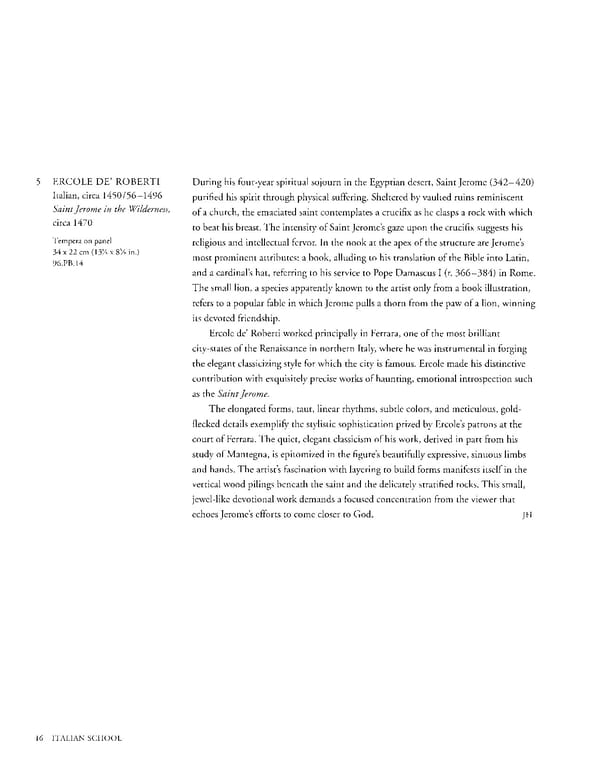5 ERCOLE DE' ROBERTI During his fouryear spiritual sojourn in the Egyptian desert, Saint Jerome (342—420) Italian, circa 1450/56–1496 purified his spirit through physical suffering. Sheltered by vaulted ruins reminiscent Saint Jerome in the Wilderness, of a church, the emaciated saint contemplates a crucifix as he clasps a rock with which circa 1470 to beat his breast. The intensity of Saint Jerome's gaze upon the crucifix suggests his Tempera on panel religious and intellectual fervor. In the nook at the apex of the structure are Jerome's 34 x22 cm (13 x 8 in.) most prominent attributes: a book, alluding to his translation of the Bible into Latin, 96.PB.14 and a cardinal's hat, referring to his service to Pope Damascus I (r. 366384) in Rome. The small lion, a species apparently known to the artist only from a book illustration, refers to a popular fable in which Jerome pulls a thorn from the paw of a lion, winning its devoted friendship. Ercole de' Roberti worked principally in Ferrara, one of the most brilliant citystates of the Renaissance in northern Italy, where he was instrumental in forging the elegant classicizing style for which the city is famous. Ercole made his distinctive contribution with exquisitely precise works of haunting, emotional introspection such as the Saint Jerome. The elongated forms, taut, linear rhythms, subtle colors, and meticulous, gold flecked details exemplify the stylistic sophistication prized by Ercole's patrons at the court of Ferrara. The quiet, elegant classicism of his work, derived in part from his study of Mantegna, is epitomized in the figure's beautifully expressive, sinuous limbs and hands. The artist's fascination with layering to build forms manifests itself in the vertical wood pilings beneath the saint and the delicately stratified rocks. This small, jewellike devotional work demands a focused concentration from the viewer that echoes Jerome's efforts to come closer to God. JH 16 ITALIAN SCHOOL
 Masterpieces of the Getty Museum: Paintings Page 16 Page 18
Masterpieces of the Getty Museum: Paintings Page 16 Page 18